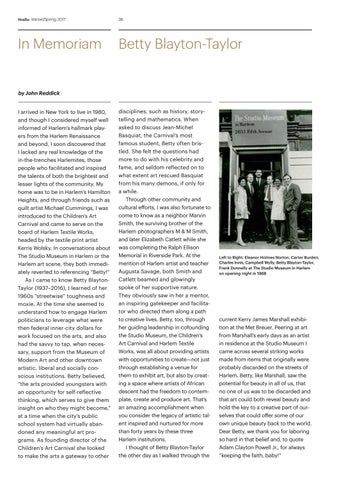Winter/Spring 2017
In Memoriam
36
Betty Blayton-Taylor
by John Reddick I arrived in New York to live in 1980, and though I considered myself well informed of Harlem’s hallmark players from the Harlem Renaissance and beyond, I soon discovered that I lacked any real knowledge of the in-the-trenches Harlemites, those people who facilitated and inspired the talents of both the brightest and lesser lights of the community. My home was to be in Harlem’s Hamilton Heights, and through friends such as quilt artist Michael Cummings, I was introduced to the Children’s Art Carnival and came to serve on the board of Harlem Textile Works, headed by the textile print artist Kerris Wolsky. In conversations about The Studio Museum in Harlem or the Harlem art scene, they both immediately reverted to referencing “Betty!” As I came to know Betty BlaytonTaylor (1937–2016), I learned of her 1960s “streetwise” toughness and moxie. At the time she seemed to understand how to engage Harlem politicians to leverage what were then federal inner-city dollars for work focused on the arts, and also had the savvy to tap, when necessary, support from the Museum of Modern Art and other downtown artistic, liberal and socially conscious institutions. Betty believed, “the arts provided youngsters with an opportunity for self-reflective thinking, which serves to give them insight on who they might become,” at a time when the city’s public school system had virtually abandoned any meaningful art programs. As founding director of the Children’s Art Carnival she looked to make the arts a gateway to other
disciplines, such as history, storytelling and mathematics. When asked to discuss Jean-Michel Basquiat, the Carnival’s most famous student, Betty often bristled. She felt the questions had more to do with his celebrity and fame, and seldom reflected on to what extent art rescued Basquiat from his many demons, if only for a while. Through other community and cultural efforts, I was also fortunate to come to know as a neighbor Marvin Smith, the surviving brother of the Harlem photographers M & M Smith, and later Elizabeth Catlett while she was completing the Ralph Ellison Memorial in Riverside Park. At the mention of Harlem artist and teacher Augusta Savage, both Smith and Catlett beamed and glowingly spoke of her supportive nature. They obviously saw in her a mentor, an inspiring gatekeeper and facilitator who directed them along a path to creative lives. Betty, too, through her guiding leadership in cofounding the Studio Museum, the Children’s Art Carnival and Harlem Textile Works, was all about providing artists with opportunities to create—not just through establishing a venue for them to exhibit art, but also by creating a space where artists of African descent had the freedom to contemplate, create and produce art. That’s an amazing accomplishment when you consider the legacy of artistic talent inspired and nurtured for more than forty years by these three Harlem institutions. I thought of Betty Blayton-Taylor the other day as I walked through the
Left to Right: Eleanor Holmes Norton, Carter Burden, Charles Innis, Campbell Wylly, Betty Blayton-Taylor, Frank Donnelly at The Studio Museum in Harlem on opening night in 1968
current Kerry James Marshall exhibition at the Met Breuer. Peering at art from Marshall’s early days as an artist in residence at the Studio Museum I came across several striking works made from items that originally were probably discarded on the streets of Harlem. Betty, like Marshall, saw the potential for beauty in all of us, that no one of us was to be discarded and that art could both reveal beauty and hold the key to a creative part of ourselves that could offer some of our own unique beauty back to the world. Dear Betty, we thank you for laboring so hard in that belief and, to quote Adam Clayton Powell Jr., for always “keeping the faith, baby!”
